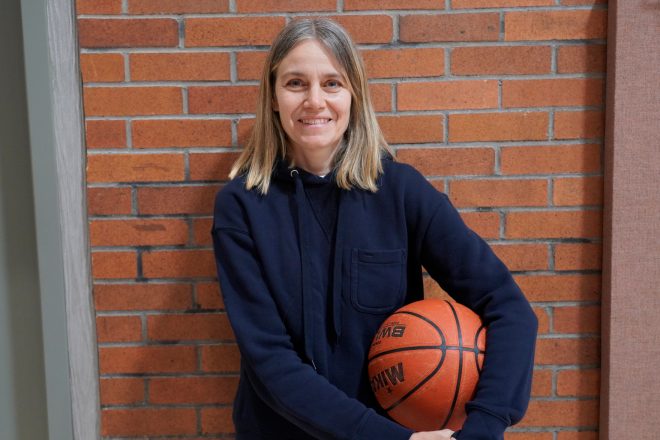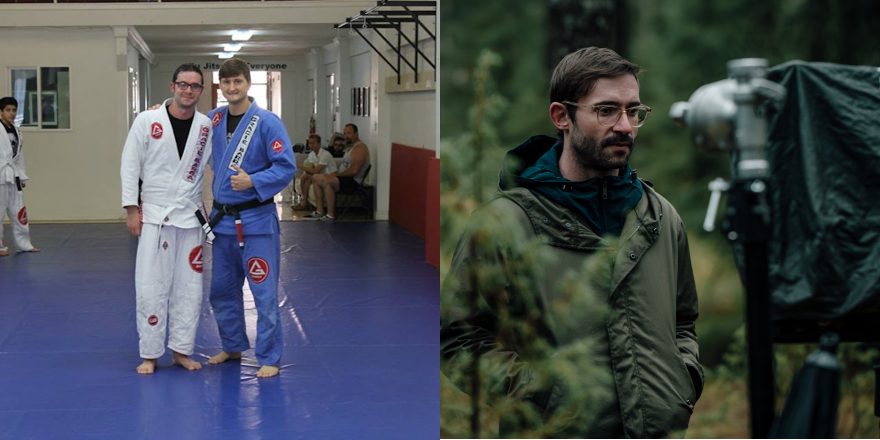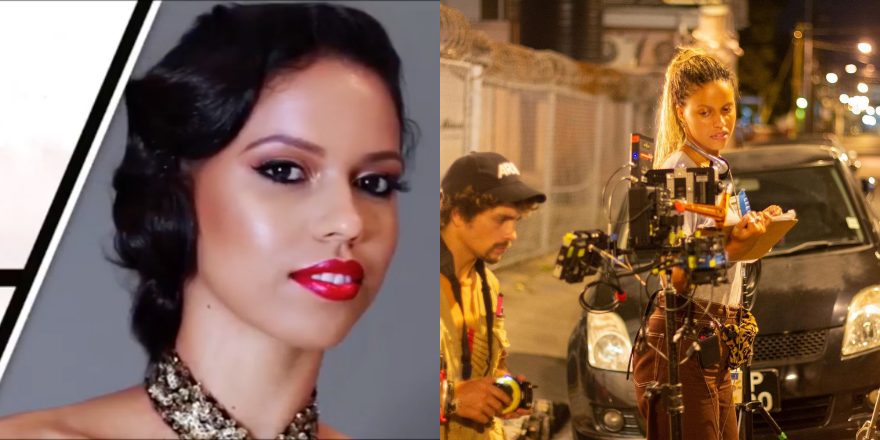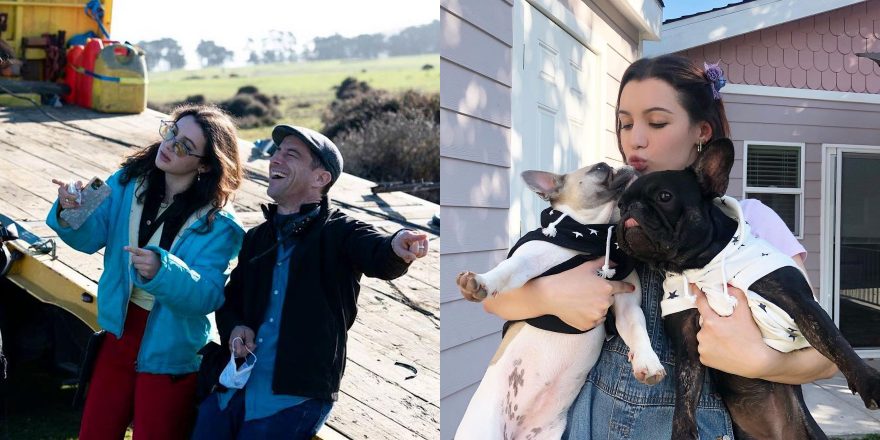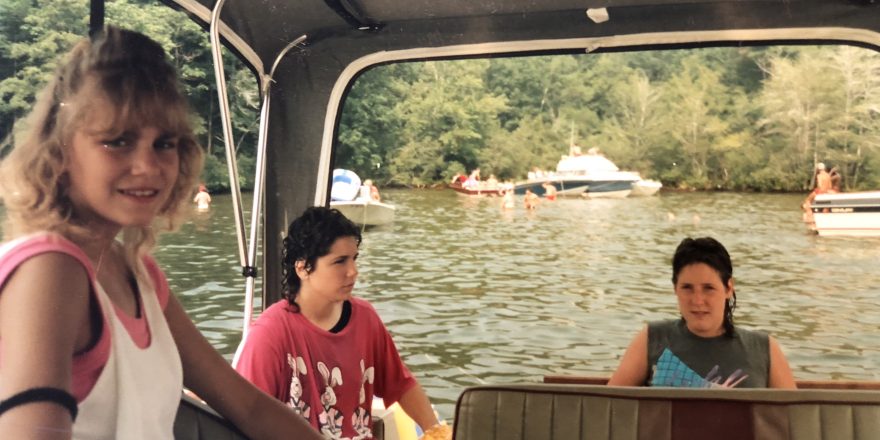I never imagined myself as a leader, a mother or a director. I never wanted to tell anyone what to do. I’m inspired by chaos and don’t desire to put order to it. I always wanted to be liked. I avoided confrontation. I never had high levels of confidence. I couldn’t see myself as a teacher. I didn’t feel I had enough knowledge to share with someone else. I never admired anyone in positions of authority. I was by nature a performer and an observer. So this past fall, when I was asked to coach a middle school basketball team, I was terrified.
There’s something about basketball … the bounce, the rhythm, the echo against the buildings as you dribble down the street to the court. An exchange of force from the palm of your hand to the earth and back. All you needed was a ball, and a few handles, to feel the power. Basketball was a way to walk out the house, a way to be independent, a way to express form and individuality, a stage to practice courage, a place to exercise aggression and learn how to control it. The court was a place to find your faults, find your gifts, and almost always find yourself. I went to the courts a lot as a teen. I never forgot what it meant for me.
I was always a player. But what did a girl in 1988 do with basketball once she left high school? For most of us, that was the end of the line. It was considered a hobby, like knitting or playing cards. There weren’t many incentives to go further when I was a kid. Scholarships for girls were just beginning to happen. There wasn’t a professional league for women back then. And honestly, most coaches didn’t take the girls that seriously. I wish someone had pushed me. But I was getting involved in other things. Partying too much. It was my fault. I left basketball behind for a while.
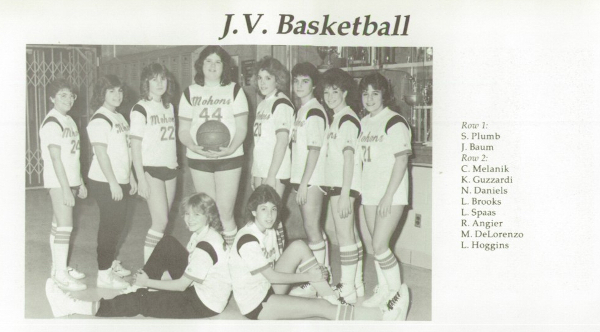
Thirty-four years later, I got a phone call. It was the gym teacher from my son’s former school. He said they needed a basketball coach. A coach?!
All I could picture was Walter Matthau in The Bad News Bears coming out of the dugout, puffing his cigar and sipping a can of beer. “You want me? I don’t know how to handle a team.”
He said, “What do you mean? You direct movies and shows. It’s the same thing.”
That was encouraging, but later I would learn a team of middle-schoolers is a lot harder than a team of movie people.
“How many girls are on the team?” I asked.
“Ummmm, actually you can’t say ‘girls’ anymore.”
“What? Ladies? Women?”
“Nope.”
“What do I say?”
“Well …”
The world had changed since I was on a court. In my time, you only got two points for today’s three-point shot. Girls were used to being sexually harassed. Date rape had no name. Kids were allowed to say the words “faggot” and “dyke” in school hallways and stinky locker rooms. Girls who dressed like guys were called tomboys.
The basketball team would not be a girls’ team in the year 2021-22. It was “girls and nonbinary.” I had to look up nonbinary.
“People who don’t identify with either of the two genders of male or female.”
This was different, but not a big deal. I was excited to be immersed in the youth culture. I agreed to coach. But I needed a partner.
The team needed Coach P. She was someone who really knew how to do this.
The school agreed to hire both of us. When the summer ended, I started to get really nervous. Basketball season was approaching. But what did I have to worry about? I had someone with me who could lead the team. I sent her a whistle and looked forward to our coaching adventure together.
Coach P was qualified for this job, and we were friends. She was a Brooklyn native with two boys who were both exceptional basketball players. She went to all their practices, all their games. She coached them from the stands at tournaments, recorded highlights of them from the sidelines, gave advice from the driver’s seat on long rides back to Brooklyn. She knew how to push and encourage. She knew when to say it as it is. She knew from classroom experience how to hold a group of kids together. She knew how to blow that whistle.
At the first practice, the gym teacher let us know who identified by what gender and what pronouns to use. Then he let us introduce ourselves. We yelled out, “All right, ladies, come into a circle!” The gym got quiet. We got some strange looks. We were corrected. Using new pronouns was going to take some practice.
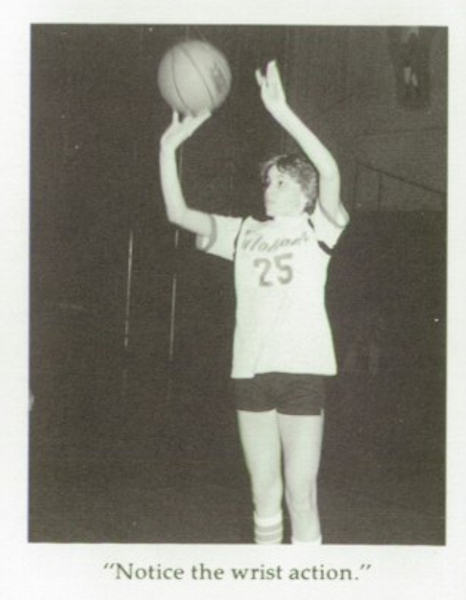
The kids sat in a circle in the middle of the court. They didn’t know us. They didn’t trust us yet. I told Coach P she should do the introduction. I was honestly too nervous, but I didn’t tell her that. She introduced herself like a coach should. Experience, enthusiasm, a laugh. Then … “And this is Coach Shannon.” I just waved.
I showed Coach P the books I’d bought about coaching basketball. She stared at me while I tried to translate the drill from the page. The pages were filled with arrows that went in opposite directions, and codes for offense and defense; the diagrams looked like the sky during a Fourth of July finale. I couldn’t read basketball. She simply responded, “What about YouTube?”
We started the practices. We had 14 players all from sixth, seventh and eighth grades. In the beginning, we messed up quite a bit with “she,” “girls,” “hers.” What do we call “man-to-man defense”? The players reminded us, like instructors of a new language, to correct the pronoun. I was impressed at how a young person at the age of 11, 12 or 13 could advocate for themselves. Their desired changes made you question the origins and motivations of He and She. These young people were challenging the existence of gender roles. Not everyone wanted to succumb to the limits of a pronoun.
Eventually, we got to calling the group “players” and “young people.” The challenging moments were during scrimmages when we were yelling “pass the ball to …!” We didn’t know all their names yet. The “she/her” would come out by default. The brain is so used to connecting the pronoun with the gender we think we see. Scrambling to use the preferred pronoun got your tongue twisted in a knot. Often what came out of my mouth, instead of “she” or “they,” was just a force of sound; something ancient and pre-pronoun. Yelling through a mask and adding a cough helped to muffle what I knew was coming out the wrong way. As soon as we knew everyone’s names, it got easier. We sincerely practiced our pronouns and the players practiced their layups.
Coach P and I were getting a routine down. Among other skills, she was good at managing the rowdiness of the team. ’Cause they could get wild. Sometimes they’d just start twerking while we demonstrated a drill. Sometimes someone would scream or break out singing “We Don’t Talk About Bruno.” Some confessed they were only there cause their dad told them to sign up. Some just because a friend was playing. There were also a few serious players. And a few who became serious.
We were learning as coaches. The players were learning the game. Every practice, we watched them make better layups, catch the ball better, get more aggressive. They improved their shots and their form. It was amazing how fast they learned. We were becoming a team. And now … we could play basketball.
We had our first game. Coach P came into the gym wearing a Just Do It sweatshirt. One player was too nervous to play. The energy was intense on our bench. This was their first game. No one got to play last year because they were on lockdown. Coach P and I were not accustomed to all the rules. The gym teacher saw that one player had nails that were too long. She disappeared and came back with bloody cuticles. She shrugged at us, holding out her fingers. “I used scissors.” Everyone had the jitters. Me too. My armpits were soaked and the game hadn’t even started yet.
The refs took to the court. The players went on. Whistle! We jumped for the ball. The other team got it. When our team recovered the ball, they ran toward their basket, confused and disoriented. Had they forgotten how to play basketball? One player skidded across the wooden floor. Another seemed to be hyperventilating. Coach P called a timeout. It was just a minute into the first quarter. The players came into the huddle in tears, eyes bulging. I don’t think any of them had experienced this much adrenaline coursing through their bodies before. They needed to embrace this unfamiliar energy. They wiped away the fear and went back on. They started to play together, to pass the ball, and they were making baskets! The ref blew the whistle. He yelled at one of our players. No jewelry! She wrestled with her ears to get out earrings that had never been removed. The game restarted. Another whistle. This time the ref was furious. Another kid with jewelry. He yelled at our player. Me and Coach P yelled back at him. The game proceeded. Unjeweled and confident, they were acclimating to the pace of a real game. And they did it! We won the game 24 to 9! Wow. Were they excited! They jumped up on each other. The small crowd roared. Coach P and I had big smiles.
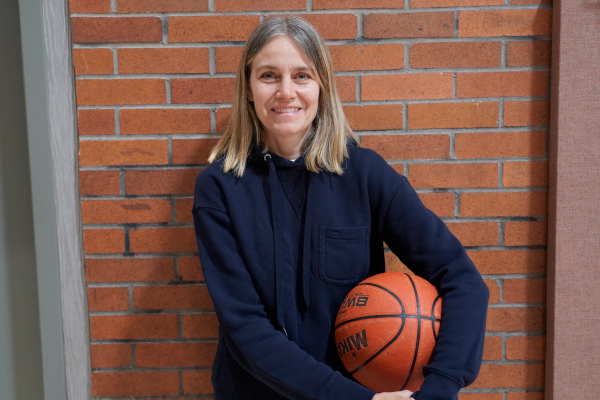
With Coach P taking on the leadership role, I could live in my comfort zone. I could be a player and join the scrimmages. I could be a kid too. I could accidentally swear. I could be goofy sometimes and demonstrate defense with a couple of my own twerks. I could be liked. This was easy!
As the season continued, Covid numbers were going up again. Many games got cancelled. Vaccinations were being mandated. By the winter, all athletes in middle and high schools had to be vaccinated. We lost a lot of players because of that. Then we lost players because their friends weren’t playing. Two players got injured with fractures. Then we lost Coach P, for personal reasons. Halfway through December, the school postponed the practices and games until after winter break.
When basketball resumed at the end of January, I was in the position I feared most. Alone with a gym full of middle schoolers. They’d lost more than half their team. Lost one of their coaches. “This sucks,” I heard them say. “Where’s Coach P?”
I had to approach the circle. I had to say something. This was a moment for a podium, a press conference, a soliloquy. Whoever speaks to the circle should know what they’re talking about. How could I say anything? I only know how to play; coaching is something entirely different. How can you make them believe they are a team and you are their leader? I was an observer and a performer. I never knew how to coach. There weren’t enough players to make a circle. “Let’s stretch!” I yelled, once again hiding behind my mask.
The first challenge was how to keep them quiet. Wow, did they chatter! I yelled to do laps. They were still talking. I yelled over their talking. They talked over my yelling. More laps? Maybe I needed a whistle.
They seemed to walk instead of run; one would disappear and be found eating Sour Patch Kids in the corner, another lounged upside down on mats while she waited her turn in a drill.
What about plays? I was scrambling through my books, trying to make sense of Xs and Os.
As our team shrunk, so did the morale. Some practices, we had three players. The players who truly wanted to play basketball were suffering. Some just gave up and the practice became a romper room. During one practice, a player walked off the court nonchalantly claiming the practice was boring. Another day, a player laid down on the foul shot line as if it were her bedroom floor. One girl screamed out of frustration when I stopped practice because the players were goofing off. These players needed a conduit, they needed glue, they needed a unifier. They needed a coach.
Believing in someone is a really powerful gift. I believed in these kids. But I didn’t believe in myself. Could they believe in me as their coach? I walked into the gym early one practice. The guard on the team approached me.
“Do you want to be called Coach Shannon?” she asked.
Did she just call me coach? “Sure.”
“Coach Shannon,” she said, “you need to yell louder!”
I felt my lips stretch toward my forehead. A giant smile grew on my face.
“OK. I will!”
And then … we dominated.
Our last away game, we had five players. There would be no subs. No breaks for anyone. The other team was super aggressive. My players were getting slapped, jabbed, scratched and shoved to the ground. By the end of the first half, the team was exhausted. We only had so many timeouts. In the third quarter, a player who had developed into a great defender stole the ball from the opponent and held on tight. Three girls from the other team attacked her and toppled her to the ground. We called our last timeout. She was shaken up and didn’t know if she’d get back on the court. If she didn’t go back, we’d have to forfeit the game with only four players. She covered her face for a minute. Then she mustered up her courage, tapped into the last drips of stored energy and returned to face her attackers. We were always two to five points ahead or behind. In the last seconds of the game, we were ahead by two points. A foul was called on us. The other team had a chance to tie. The opponent shot from the foul shot line and missed. Our player got the rebound. She held on tight. She threw it to a guard. And … game over! We won! Our point guard came running, barreling toward me. She jumped into my arms and gave a giant hug. The rest of the team followed. I choked up with tears, swarming in a huddle of adrenaline, smiles and sweat. They did it! They played as hard as they could. They proved to themselves and everyone watching that they had a team. They proved they could rise up to any challenge.
Our record was eight wins, one loss … I understand now. A coach is observant like a performer. A coach is selfless and enforces discipline like two parents in one. A coach looks at the individual player while at the same time seeing the whole team, like a director sees the actor within the context of a whole movie. A coach sees the specialty in each person. A coach encourages. A coach is a leader, but a teacher too. A coach is there for the team. I think I might get myself a whistle.


